Cancer in Dogs: How Common is It and Can it Affect Your Dog?
Unfortunately, cancer in dogs is common. Around 25% of all dogs develop cancer in their life. 50% of all senior dogs have been diagnosed with cancer as per the AAHA.
Cancer in dogs can affect the skin, breast, digestive system and reproductive system.
Cancer in pets doesn’t have to be a death sentence. Early diagnosis, correct treatment and post-cancer checkups are keys to a healthy life of any pet.
Keep reading to learn more about the signs, causes, treatment and prevention of cancer in dogs.
What are the Signs of Cancer in Pets?
Cancer is not just one disease. It can affect any organ or organ system. Some cancers are visible as lumps on the body, while others grow stealthily inside the body.
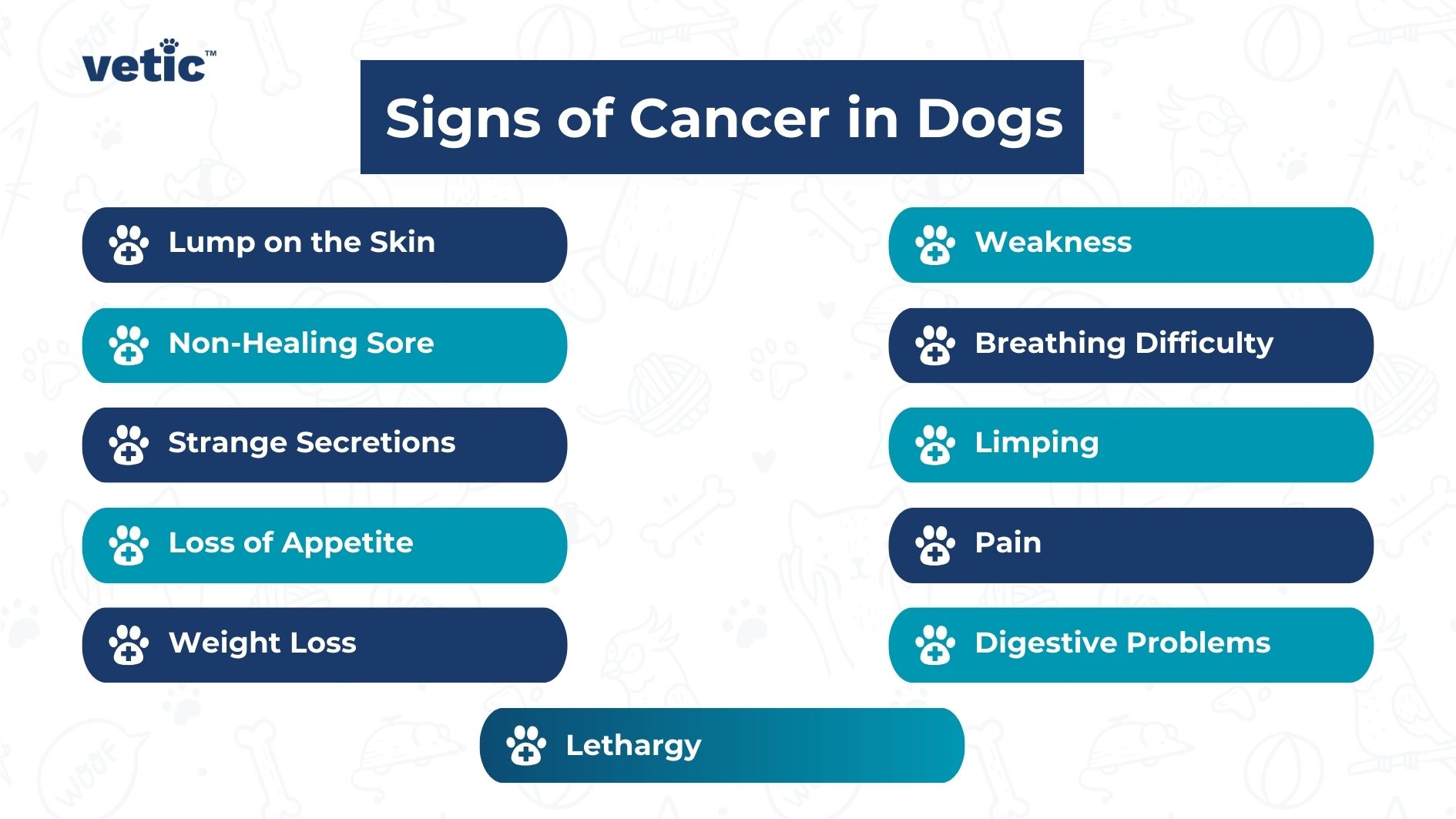
Nonetheless, there are some common signs of cancer in dogs that are visible once the pet is affected. Sadly, some signs and symptoms of cancer in dogs only show up after the disease has spread or metastasised to other organs.
The signs of cancer in dogs include –
- Lump or Growths on The Skin
- Sores or Wounds That Won’t Heal
- Sudden Weight Loss
- Digestive Issues
- Appetite Loss
- Lethargy
- Weakness
- Limping or Limb Pain
- Breathing Difficulty
Here’s how you can also observe the early signs of cancer in dogs –
- Lump on the Skin: Feel for any unusual bumps or lumps on your dog’s body.
- Non-Healing Sore: Keep an eye on any wounds or sores that don’t seem to be getting better.
- Loss of Appetite: If your dog suddenly loses interest in food, it could be a sign of a problem.
- Weight Loss: Unexplained weight loss without changes in diet or exercise can indicate an underlying issue.
- Lethargy and Weakness: Watch for decreased energy levels or weakness in your dog.
- Difficulty Breathing: Notice if your dog seems to be struggling to catch their breath or breathing abnormally.
- Limping: Be aware of any limping or difficulty moving around, especially if it’s persistent.
- Digestive or Tummy Problems: Pay attention to any recurring digestive issues or tummy troubles.
Remember, these symptoms can also signal other illnesses, not just cancer. If you notice any of these signs, it’s best to have your pet checked out by a vet. Even though cancers can be slow-growing, they sometimes cause sudden changes in health.
What are Some of the Most Common Types of Cancer in Dogs?
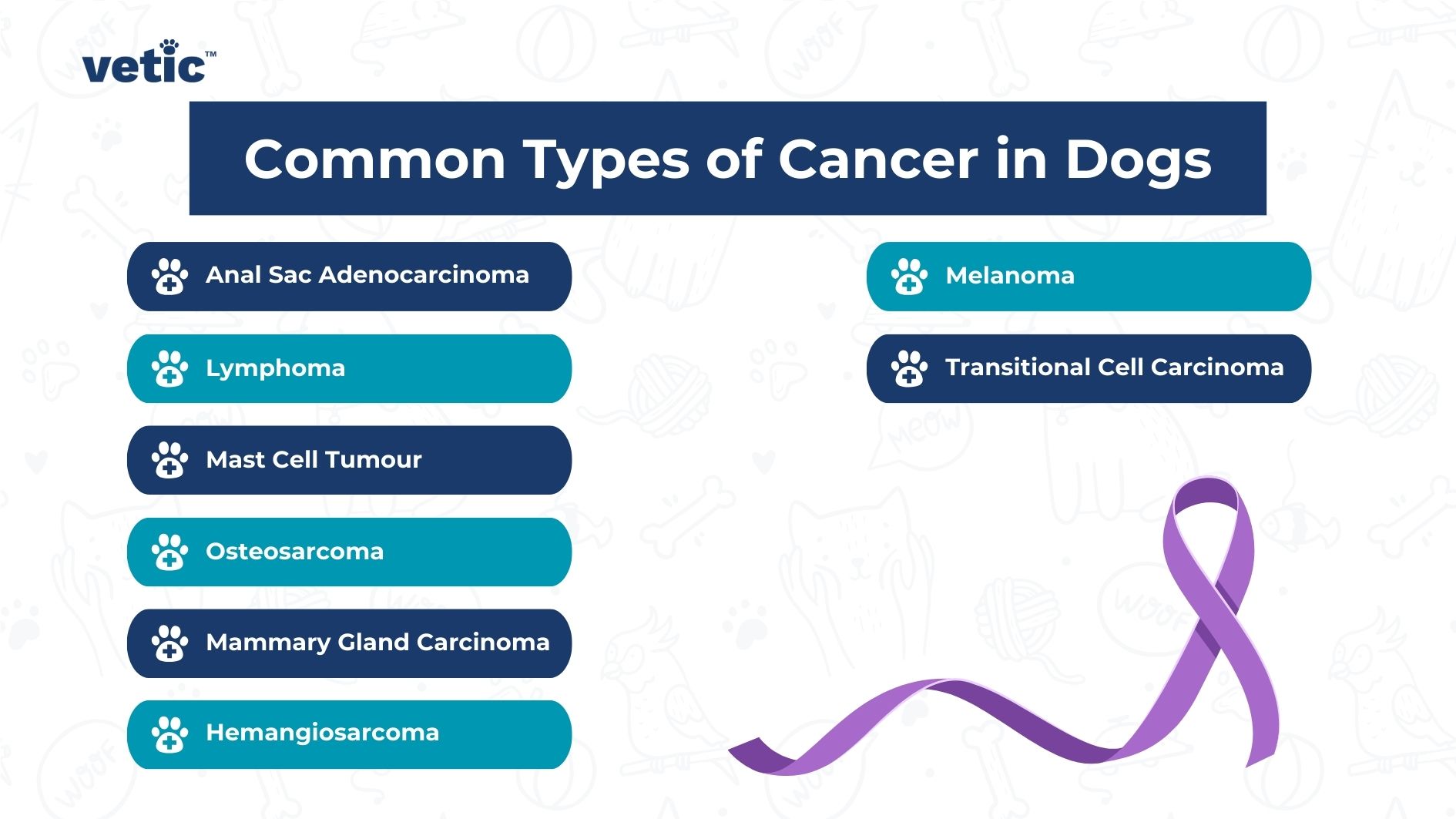
Cancer is not uncommon in dogs, and there are various types of cancers that can affect them. Some of the common dog cancer types include –
- Anal Sac Adenocarcinoma: This cancer targets the scent glands near the rear end. It can spread to other parts of the body.
- Hemangiosarcoma: This tumour usually starts in blood vessels and can show up in different organs like the heart, liver, or spleen. It spreads quickly.
- Lymphoma: Dogs can get different types, but the most frequent affects their lymph nodes. The good news is, it often responds well to chemotherapy.
- Mammary Gland Carcinoma: Unspayed female dogs are more at risk. Hormones like oestrogen and progesterone can influence its development.
- Mast Cell Tumour: The most common skin cancer in dogs. It’s tricky because its appearance varies, and it can be either less or more likely to spread.
- Melanoma: These can show up on the skin or in the mouth. Mouth melanomas are often aggressive and need serious treatment.
- Osteosarcoma: Mainly affects large dog breeds, usually in their legs. It’s painful and spreads fast. Treatment involves surgery and sometimes chemo or radiation.
- Transitional Cell Carcinoma: Affects the urinary system, especially the bladder. It can cause symptoms similar to a urinary tract infection.
This is not an exhaustive list. However, these are the most common types of cancer that affects dogs around the world. Many of these cancers are common among senior dogs irrespective of their pedigree and breed.
Why Has Cancer in Dogs Become More Common Now?
Pets enjoy a longer life due to improved preventive care such as vaccinations and tick repellents. The average lifespan of large breed dogs is now around 8-12 years, medium dogs is around 10-13 years and small breed dogs is 10 to 18 years!
The added years to their life give them additional time with their loving family, but also gives mutations the time to accumulate in their body. Additionally, exposure to potential carcinogens throughout their extended lifespan predisposes them to cancer in their senior years.
Is Cancer in Pets Preventable?
Even with extensive research, no one knows what causes these cancers. Some of the cancers like mammary cancers, prostate and testicular cancers, uterine and ovarian cancers are preventable by neutering (spaying) dogs before their first heat.
However, certain breeds of dogs such as the Golden Retriever, become predisposed to hemangiosarcoma due to early neutering. The gender of the dog (male) also plays a significant role in increasing the risk of cancer development post neutering.
Do Specific Dog Breeds Have Higher Predisposition Towards Cancer?
Purebred dogs that have undergone inbreeding for more than one generation have a high risk of developing at least one type of cancer.
However, there are other purebred dogs (without any history of inbreeding) which show a higher incidence of cancer. Some of the common dog breeds with a higher incidence of cancer include –
- Golden retriever
- Rottweiler
- Staffordshire bull terrier
- Boxer
- French bulldog
- Alaskan malamute
- Saluki
- Bullmastiff
- Beagle
- English setter
- Siberian husky
- Basset hound
- Labrador retriever
- Afghan hound
- Standard poodle
- Cocker spaniel
- Irish setter
Osteosarcoma, lymphoma, mast cell tumour and melanoma were the most common cancers that were observed in these breeds.
Your Dog Has a Lump. Is It a Tumour or Cancer?
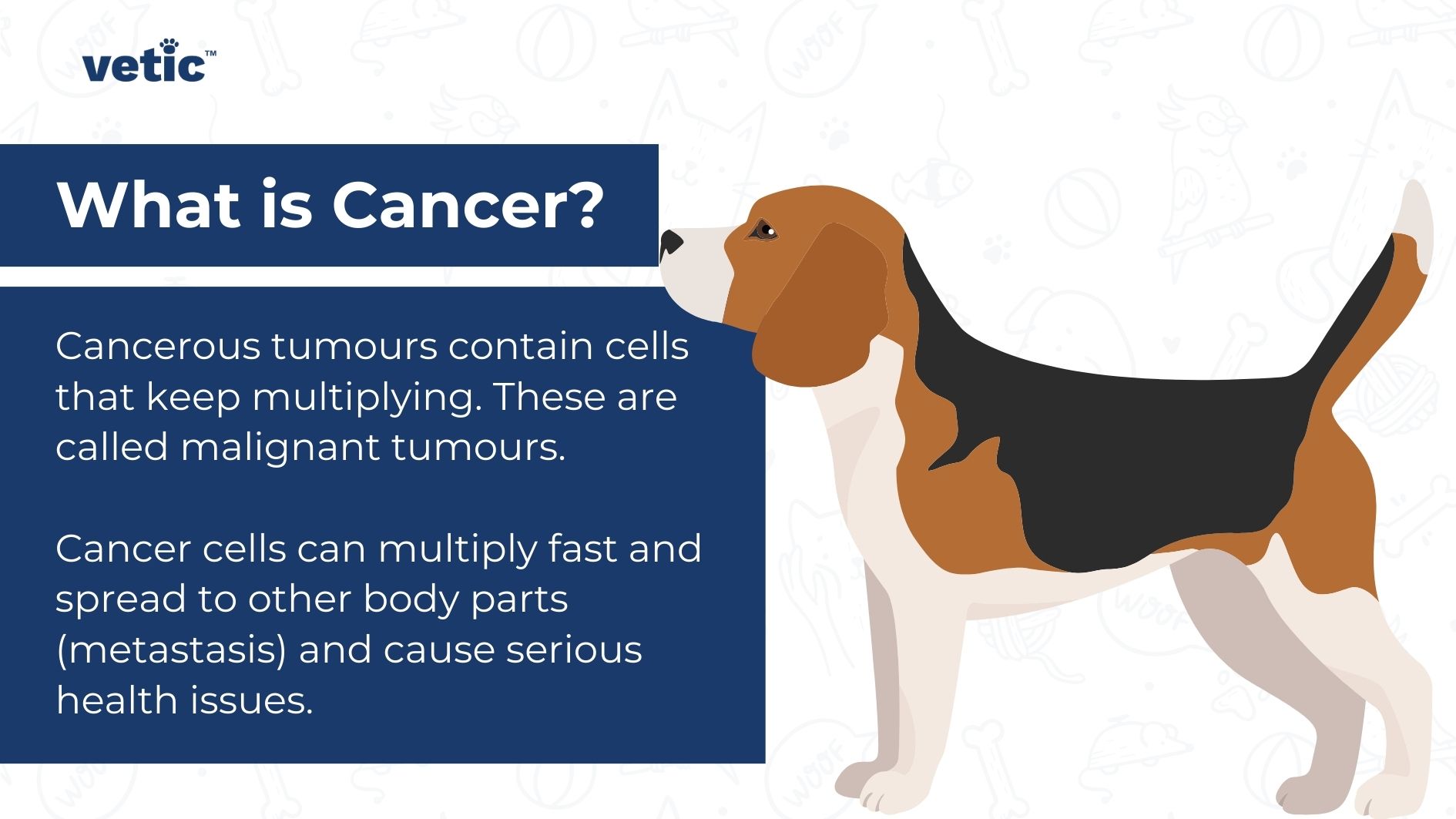
It’s not unusual for dogs to develop lumps or masses, but not all of them are cancerous. When a lump isn’t cancerous, it’s called benign. Usually, benign lumps grow slowly and stay put, so they’re not a big health concern.
On the other hand, cancerous lumps contain cells that keep multiplying. These are called malignant tumours and can grow fast, spreading to other body parts (metastasis of cancer in dogs) and causing serious health issues. The speed of growth and where it spreads depend on the type of cancer.
How Does a Cancerous Tumour in Dogs Look?
When it comes to lumps on your dog, it’s tough to tell if they’re cancerous just by looking. So, don’t try to diagnose them yourself.
These lumps come in all shapes and sizes, from firm to soft, and they might look different too. Some could be bare or coloured, while others might be sore or painless, and some you can feel under the skin, while others sit on top.
It’s essential to distinguish these lumps from your dog’s lymph nodes. Dogs have a few sets of lymph nodes scattered around their body, like under their jaw, in front of their shoulders, under their armpits, and behind their knees.
Normally, these are small, oval-shaped, and not painful. But if they get bigger, it could be a sign of cancer in dogs.
If you notice a new lump on your pet, don’t wait. Make an appointment with your vet to get it checked out properly.
How is Cancer in Dogs Diagnosed?
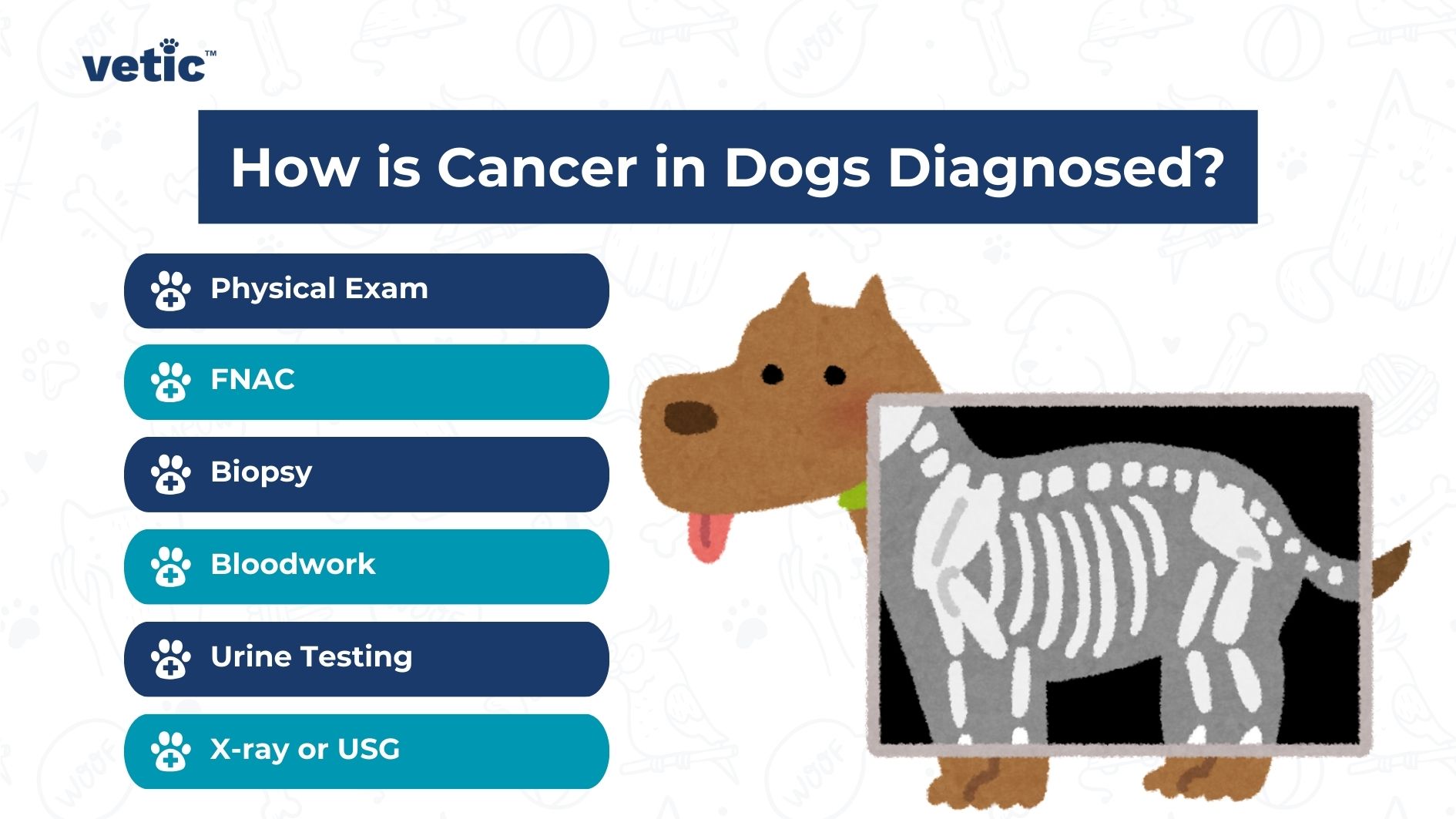
Cancer in dogs comes in different shapes and sizes. They can be of different types and their location can vary as well.
Sometimes, simply looking at a lump or discolouration of the skin isn’t enough to confirm the diagnosis of cancer. The veterinarian will conduct multiple tests for the differential diagnosis. These tests for cancer in dogs include –
- Physical Exam: Your vet checks for any unusual lumps, bruises, or masses that can be felt on your dog’s body by gently pressing.
- Fine-Needle Aspiration Cytology (FNAC): If there’s a suspicious lump, a small sample is taken using a thin needle for analysis.
- Biopsy: For a more detailed look, a larger sample of the lump is taken, often while your dog is sedated or under anaesthesia. This sample is studied to understand the type, aggressiveness, and grade of the cancer.
- Bloodwork and Urine Testing: These tests help narrow down the problem to a specific organ or body system by looking for abnormal signs.
- Imaging (Radiographs or Ultrasound): Used to check for masses in the chest or abdomen, giving a clearer picture of what’s going on inside your dog’s body.
Further Testing and Treatment: If cancer is confirmed, your vet might suggest more tests or send you to a specialist for additional care. This could involve CT scans, bone marrow tests, or more biopsies to determine the extent of the cancer’s spread, a process called staging.
Understanding the type, grade, and stage of the cancer helps your vet predict how it might progress and what treatment options are best.
Generally, the higher the grade and stage, the more challenging the prognosis.
What’s the Treatment for Cancer in Dogs?
Since cancer is an umbrella term that includes hemangiosarcoma, osteosarcoma, lymphoma, mast cell tumours, melanoma and cancers of the reproductive organs, the treatment for cancer in dogs varies significantly according to the grade, stage and location of the cancerous growth(s).
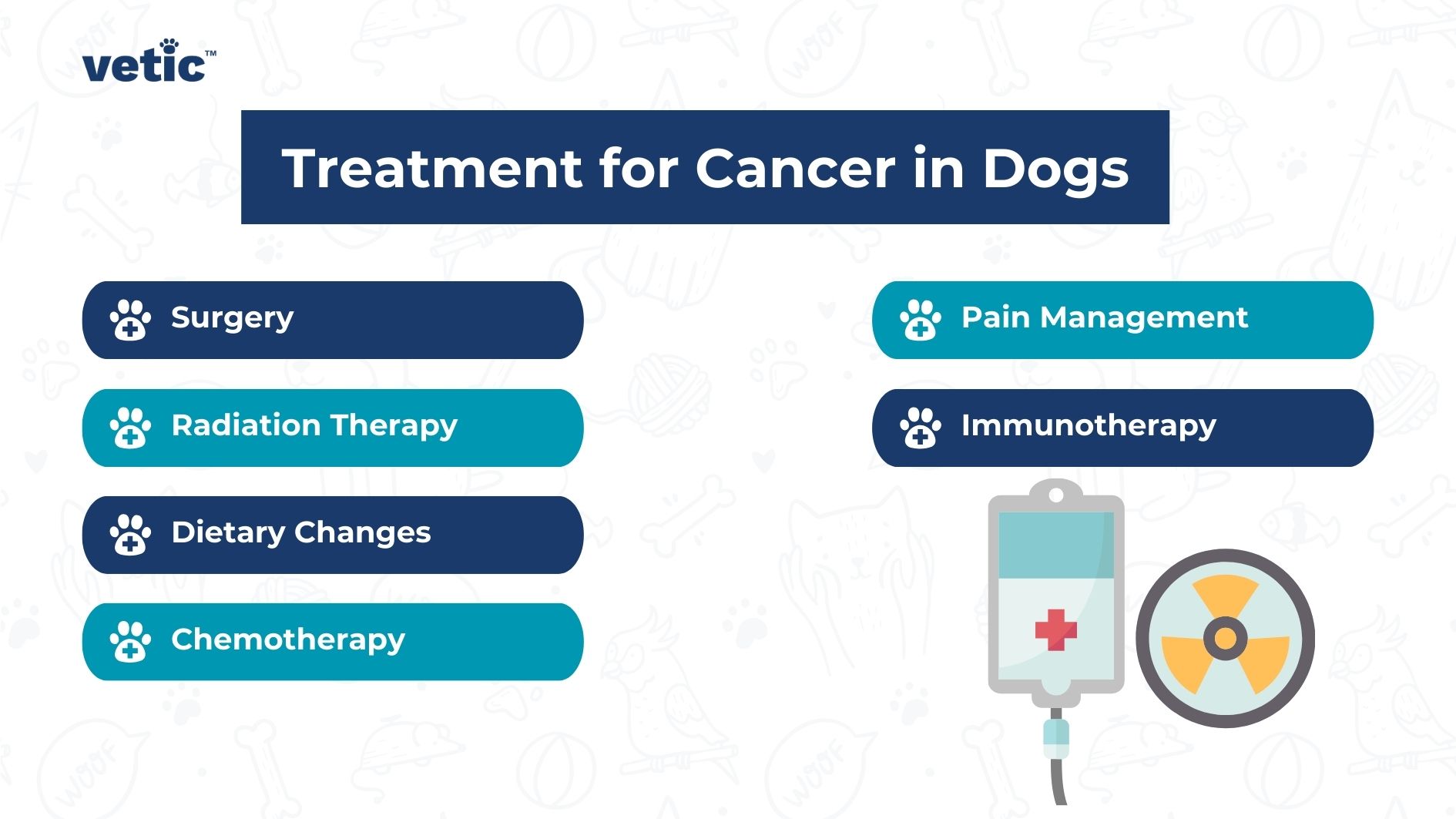
Here are some of the conventional practices followed by veterinarians in India for treating cancer in dogs –
- Surgery: Removing the cancerous growth through an operation.
- Chemotherapy: Using medications to kill cancer cells or stop them from growing.
- Radiation Therapy: Targeting the cancer with high-energy beams to shrink or destroy it.
- Cryosurgery (Freezing): Freezing the cancer cells to kill them.
- Hyperthermia (Heating): Heating the cancerous area to destroy the cells.
- Immunotherapy: Boosting the body’s immune system to fight off the cancer.
- Dietary Changes and Other Therapies: Adjusting your pet’s diet or trying other treatments to support their overall health and response to treatment.
- Pain Management: Providing relief from any discomfort or pain associated with the cancer or its treatment.
Is Cancer Treatment in Dogs Expensive?
Not all cancers require costly treatment. Some common ones such as TVT may require chemotherapy followed by neutering or spaying to prevent a recurrence. The cost of transmissible venereal tumour treatment in dogs is quite affordable these days and the prognosis is also fair (for early stages).
Other types of cancers such as lymphoma, osteosarcoma and hemangioma may require specialised treatment, surgery and care.
The cost of cancer treatment in dogs depends not only on the type and stage of cancer, but also on the choice of clinics.
With more advanced medicine and therapy, some cancers in pets are manageable and even curable.
Having a pet health insurance of course helps with the financial strain. Nonetheless, you should consider all available options of treatment and clinics before you make a decision.
Research your options carefully, meet with multiple veterinarians and speak with pet clinics near you to compare the cost of cancer treatment in dogs.
How Long Can a Dog with Cancer Live?
How long a dog will live after cancer diagnosis depends upon numerous factors including the course of treatment.
- Early Diagnosis: Catching the cancer early helps in providing the best possible care.
- Stage: How advanced the cancer is and whether it has spread.
- Type: Determines how likely it is to respond to treatment and how fast it spreads.
Consultation with a veterinary oncologist is a must if your dog has cancer. An oncologist should be able to give you a better idea about the outcome of cancer treatment in dogs and the prognosis for your pet.

